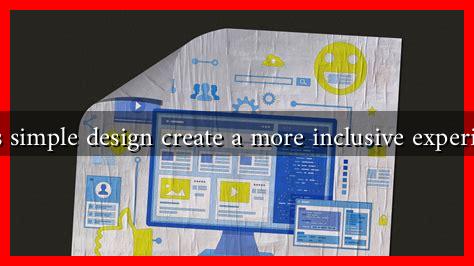-
Table of Contents
Does Simple Design Create a More Inclusive Experience?
In an increasingly digital world, the importance of design cannot be overstated. As we navigate websites, apps, and various digital interfaces, the question arises: does simple design create a more inclusive experience? This article explores the relationship between simplicity in design and inclusivity, examining how straightforward design principles can enhance accessibility for diverse user groups.
The Essence of Simple Design
Simple design refers to the practice of creating interfaces that are easy to understand and navigate. This approach often emphasizes minimalism, clarity, and functionality. The core principles of simple design include:
- Clarity: Information is presented in a straightforward manner, reducing cognitive load.
- Consistency: Design elements are uniform across the platform, making it easier for users to predict interactions.
- Accessibility: Features are designed to be usable by people with varying abilities and disabilities.
By adhering to these principles, designers can create experiences that are not only aesthetically pleasing but also functional for a broader audience.
The Impact of Simple Design on Inclusivity
Inclusivity in design means creating products that can be used by everyone, regardless of their abilities or backgrounds. Simple design plays a crucial role in achieving this goal. Here are several ways in which simple design fosters inclusivity:
1. Enhanced Accessibility
Simple design often incorporates accessibility features that cater to users with disabilities. For instance:
- High-contrast color schemes help users with visual impairments.
- Clear typography and larger font sizes benefit those with reading difficulties.
- Intuitive navigation aids users with cognitive disabilities.
According to the World Health Organization, over 1 billion people worldwide experience some form of disability. By prioritizing simple design, companies can ensure that their products are usable by this significant demographic.
2. User-Centric Approach
Simple design focuses on the needs and preferences of users. This user-centric approach can lead to:
- Increased user satisfaction, as individuals find it easier to interact with the product.
- Higher engagement rates, as users are more likely to return to a platform that is easy to use.
- Reduced frustration, which is particularly important for users who may not be tech-savvy.
For example, the website for the UK government (GOV.UK) employs a simple design that prioritizes user needs, resulting in a more inclusive experience for citizens seeking information and services.
3. Cultural Sensitivity
Simple design can also transcend cultural barriers. By using universally understood symbols and straightforward language, designers can create experiences that resonate with a global audience. This is particularly important in a multicultural society where users may have different levels of language proficiency and cultural context.
For instance, the use of icons instead of text can help convey messages more effectively across diverse populations. A study by the Nielsen Norman Group found that users from different cultural backgrounds often interpret visual elements similarly, making simple design a powerful tool for inclusivity.
Case Studies: Success Stories in Simple Design
Several organizations have successfully implemented simple design principles to create inclusive experiences:
- Airbnb: The platform’s user interface is designed to be intuitive, allowing users of all backgrounds to easily navigate listings and book accommodations.
- Apple: Apple’s commitment to accessibility is evident in its products, which feature VoiceOver, a screen reader that makes it easier for visually impaired users to interact with devices.
- Google: Google’s Material Design guidelines emphasize simplicity and accessibility, ensuring that their applications are usable by a wide range of users.
Conclusion
In conclusion, simple design is not just a trend; it is a necessity for creating inclusive experiences in our digital world. By focusing on clarity, accessibility, and user-centric principles, designers can ensure that their products cater to a diverse audience. As we continue to innovate and develop new technologies, embracing simple design will be crucial in fostering inclusivity and ensuring that everyone can participate in the digital landscape. For more insights on inclusive design, consider exploring resources from the W3C Web Accessibility Initiative.


